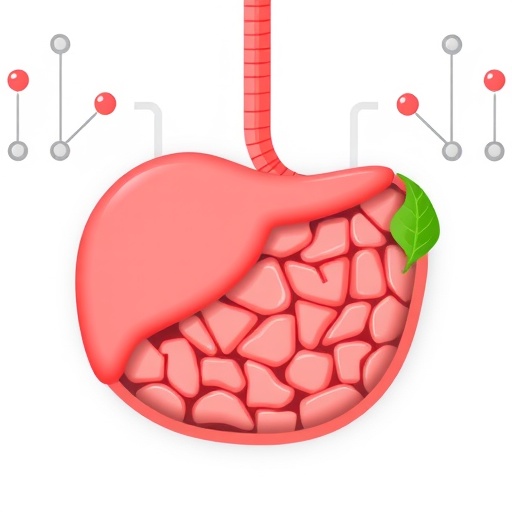In a groundbreaking study published by Chen, Y. et al. in BMC Endocrine Disorders, the intricate relationship between a genetic marker known as AIP (Adipocyte Inflammation Pathway) and the onset of type 2 diabetes mellitus (T2DM) in individuals suffering from Non-Alcoholic Fatty Liver Disease (NAFLD) has been elucidated. This retrospective investigation signifies a crucial advancement in our understanding of how genetic predispositions can influence metabolic diseases, particularly in the context of obesity and fatty liver conditions.
NAFLD has emerged as a global health crisis, affecting millions and serving as a precursor for more severe complications like T2DM. The study examined a cohort of patients diagnosed with NAFLD, evaluating the incidence of T2DM and its correlation with variations in the AIP gene. This genetic marker, previously implicated in various metabolic syndromes, has now been positioned at the forefront of the conversation surrounding diabetes risk management in patients already burdened with liver dysfunction.
One of the most striking implications of Chen and colleagues’ findings is the potential for genetic screening. By identifying patients with elevated AIP levels, healthcare providers could preemptively address diabetes risk. This could lead to the development of tailored interventions aimed at mitigating T2DM onset in those at high risk due to their genetic makeup. Such preemptive strategies are essential in a world that is increasingly plagued by lifestyle diseases linked to metabolic dysfunction.
As the study meticulously sifted through medical records, the authors revealed fascinating statistical correlations. Patients who presented with specific variations in the AIP gene were observed to have significantly higher rates of T2DM relative to those with no such genetic predisposition. This finding reinforces the importance of genetic epidemiology in comprehending the complex interplay between our biological makeup and environmental factors like diet and physical activity.
Furthermore, the researchers noted that NAFLD patients with a genetic predisposition to elevated AIP were more likely to exhibit deteriorating liver functions, which could further amplify their risk of developing diabetes. This bi-directional relationship emphasizes that NAFLD does not merely serve as a benign scaling of liver fat but is a significant risk factor that warrants attention among healthcare professionals. With the rising incidences of NAFLD globally, particularly among younger populations, the implications of this research are profound.
The implications of the study do not stop at mere identification; they extend into the realm of treatment. With insights gleaned from this research, novel therapeutic regimens could be formulated, focusing on modifying the inflammatory pathways activated by the AIP gene. Current diabetes management strategies can be enhanced by incorporating genetic insights, which would revolutionize the approach to treatment in at-risk populations.
Another critical aspect of understanding the AIP gene’s role in diabetes risk is its interaction with lifestyle factors. The study suggests that the combination of a poor diet, sedentary lifestyle, and elevated AIP levels may create a perfect storm for metabolic dysfunction. Therefore, public health initiatives advocating for healthy living could be significantly bolstered by genetic screenings, pushing forward personalized health management.
As researchers continue to explore the associations found in this study, it becomes increasingly evident that the future of diabetes prevention must account for genetics. The research prompts a deeper inquiry into how individuals might leverage their genetic knowledge to reduce their risk of T2DM. Health education around these findings can empower patients, making them more proactive in their wellness journeys, particularly for those with a familial history of metabolic disorders.
Moreover, the study opens up a plethora of avenues for future research. Investigating the downstream effects of the AIP gene on insulin resistance and glucose metabolism will be crucial for devising effective interventions. Understanding the exact mechanisms through which AIP influences T2DM risk could lead to innovative approaches in managing this chronic condition, underscoring the necessity for further in-depth analysis.
The implications of the findings from Chen et al.’s study could also reshape policy discussions surrounding diabetes prevention and intervention strategies. Comprehensive healthcare policies that integrate genetic testing could become a reality, allowing for resource allocation toward at-risk populations based on empirical data from genetic studies. This shift could mean a significant reduction in the national healthcare burden associated with T2DM.
Furthermore, the potential for early identification and intervention could lead to improved quality of life for patients suffering from not only NAFLD but also T2DM. The transformative nature of this research holds the promise of bridging gaps in care and potentially transforming a once inevitable diagnosis into a manageable condition through advanced genetic understanding.
In summary, Chen, Y., Bai, Q., and Hua, H.’s retrospective study represents a pivotal step in uncovering the genetic underpinnings of T2DM risk in NAFLD patients. As science moves towards a more integrated approach encompassing genetics in metabolic disorder management, the urgency for further exploration in this area becomes increasingly clear. The identification of AIP as a risk factor could pave the way for innovative prevention strategies and personalized healthcare, marking a significant leap forward in our collective fight against diabetes and its associated challenges.
The landscape of diabetes research is undoubtedly changing, and the findings presented in this study will likely resonate within the medical community for years to come. As we advance in our ability to understand and address the genetic factors that influence disease, the potential for improved health outcomes becomes infinitely brighter.
Subject of Research: Association between AIP and incident T2DM in patients with NAFLD.
Article Title: Association between AIP and incident T2DM in patients with NAFLD: a retrospective study.
Article References: Chen, Y., Bai, Q. & Hua, H. Association between AIP and incident T2DM in patients with NAFLD: a retrospective study. BMC Endocr Disord 25, 221 (2025). https://doi.org/10.1186/s12902-025-02046-4
Image Credits: AI Generated
DOI: 10.1186/s12902-025-02046-4
Keywords: AIP, T2DM, NAFLD, genetic predisposition, metabolic diseases.




